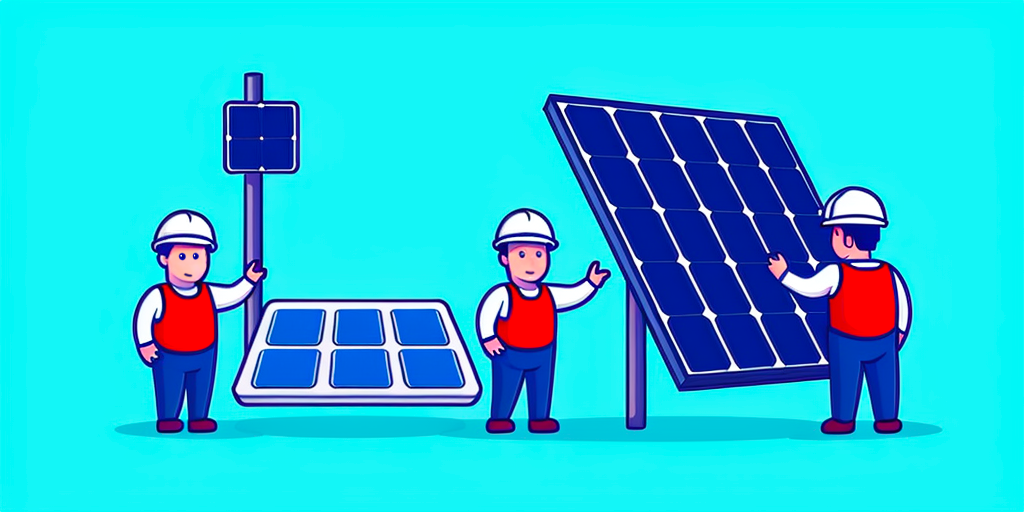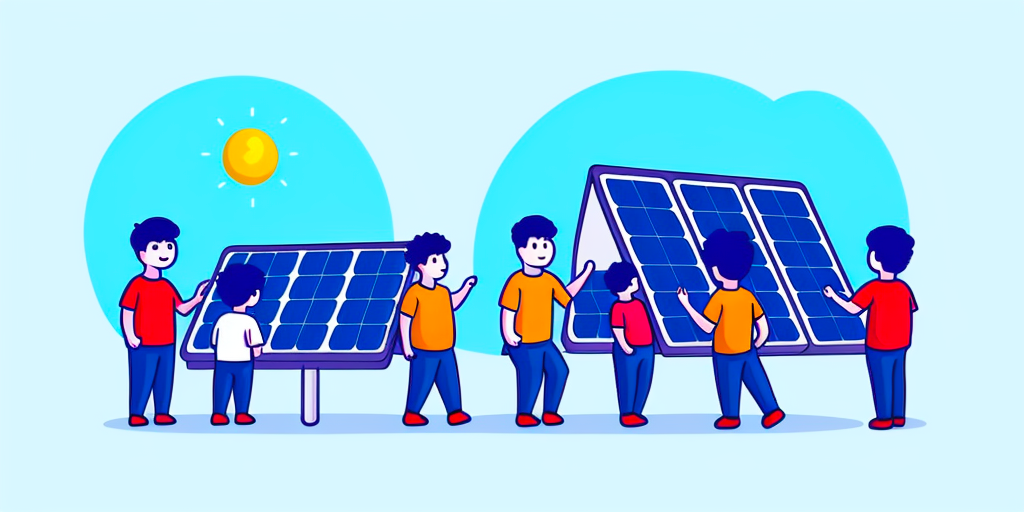Solar energy is one of the world’s fastest-growing renewable energy sources. As costs keep falling, solar power is becoming increasingly affordable to homes and businesses alike. In this article, we present 25 fascinating solar energy facts that highlight the significant progress and undeniable benefits of embracing solar power.
Solar energy has achieved a historic milestone by becoming the most affordable source of electricity ever recorded. Recent years have witnessed a remarkable transformation, with solar power surpassing the cost competitiveness of traditional fossil fuels in many regions worldwide. The World Energy Outlook’s 2020 report provides compelling evidence, revealing that solar electricity prices were 20-50% lower than previous estimates, depending on the geographical location. This dramatic cost reduction is not limited to solar energy alone; estimates for onshore and offshore wind power have also experienced a similar downward trend. Technological advancements and the expansion of production capacity have played pivotal roles in driving these remarkable cost reductions. This significant achievement in affordability positions solar energy as an attractive option for households, businesses, and governments seeking both economic benefits and a sustainable energy future.
You read that correctly—Earth intercepts a massive amount of solar energy. Approximately 30% of the solar radiation that reaches our planet is reflected back into space, not contributing to our climate system. The other 70% plays a significant role. Out of this, 23% is absorbed in the atmosphere by various elements such as water vapor, atmospheric particles, dust, and ozone. The remaining 47% traverses the atmosphere and is absorbed by the Earth’s land and oceans, which constitute nearly 71% of the globe. This means that each year, the Earth absorbs about 70% of the solar energy that reaches it, which is approximately 3.85 million exajoules. To put this into perspective, the amount of solar energy that reaches the Earth in a single hour is more than enough to meet the world’s energy needs for an entire year. So, if we can continue to innovate and improve our solar capture and storage technologies, the vast energy that the Earth receives from the sun every hour could truly revolutionize our energy consumption and sustainability practices worldwide.

The Sahara Desert receives enough sunlight to power the entire world, and with technological breakthroughs, harnessing this energy is becoming increasingly realistic. However, considerable obstacles must be overcome, such as the high cost of transporting electricity from the Sahara to other areas of the world and the lack of infrastructure to sustain solar power in the region. Nonetheless, the potential for solar energy in the Sahara is substantial, and it has the potential to play an important part in satisfying the world’s energy demands in the future.
Photovoltaic (PV) cells, which transform sunlight directly into electricity, were initially developed for space missions during the mid-20th century. In the 1950s, these PV cells were first used on American and Soviet satellites, proving to be a perfect power source due to their light weight, easy installation, and prolonged power generation without needing fuel or maintenance. Later, the same technology found its way into consumer electronics, powering devices like calculators and wristwatches. The widespread application of solar power on a larger scale, including solar power plants and rooftop solar panels, came about much later due to advancements in PV technology, heightened environmental awareness, and supportive government policies.

When sunlight photons strike solar panel photovoltaic cells, electrons in the silicon are put into motion, creating an electric current that is sent to your home’s electric distribution box to power your essential items. Solar panels can operate efficiently in a range of temperatures, but they generally perform better in cooler conditions. Research has shown that solar panel efficiency begins to decline around 77°F (25°C). As temperatures rise above this threshold, the performance of solar panels may start to decrease. However, it’s worth noting that even in hotter temperatures, solar panels can still generate electricity effectively, albeit potentially at a slightly lower efficiency. The specific temperature range at which solar panels work optimally may vary depending on factors such as panel design, location, and other environmental conditions.
Solar panels not only save money on electricity bills, but they can also raise the value of a home. According to studies, solar panels can boost the value of a home by up to 4%, making them a sensible investment for homeowners trying to increase the value of their property. As eco-consciousness becomes more prevalent, homes equipped with solar panels can appeal to those interested in sustainability and energy independence. Moreover, the value increase derived from solar installations tends to outweigh the initial investment over time. As the cost of solar panels continues to decline, the return on investment becomes more enticing. This trend signals a favorable climate for those considering investing in solar energy, where the benefits extend beyond environmental sustainability to include substantial financial returns.
Yes, and this figure is projected to rise in the future as demand for renewable energy rises and the cost of solar energy falls. Solar energy is becoming a more popular alternative for homeowners wishing to decrease energy bills and promote sustainability. This is further backed by government policies that support and encourage the expansion of the solar energy industry. According to the Department of Energy, solar energy is one of the most rapidly expanding clean energy sources in the United States. Over 1 million of the current 3 million solar energy installations were built in the last two years alone, suggesting a significant growth trajectory. A notable surge in residential solar power usage has been witnessed, particularly since 2005 when Congress passed a tax credit for residential solar generation. The National Renewable Energy Laboratory reports that since this legislation, the number of U.S. homes with solar panel installations has increased by an average of 32% per year. By the end of 2020, approximately 2.7 million residential solar systems were reported across the country.
The solar energy industry in the United States is a thriving sector that is rapidly expanding and creating job opportunities. As of 2021, it provides employment for over 255,000 individuals and fosters technological innovation, experiencing a growth rate of 9.2% compared to the previous year. This remarkable job growth reflects the rapid expansion of the U.S. solar industry, expanding at a rate five times faster than the overall job market. Between 2014 and 2019, solar employment increased by 44%, significantly outpacing the national average. The widespread adoption of solar power at residential and commercial levels contributes to the decentralization of solar power production and its broad appeal across the country. The Solar Foundation’s National Solar Jobs Census consistently reveals substantial growth in the U.S. solar workforce, with American solar jobs increasing by 167% over the past decade. This strong growth demonstrates the industry’s resilience and its contribution to the overall economic landscape, with solar employment increasing in 31 states in 2019, led by Florida, followed by Georgia, Utah, New York, Texas, Illinois, and Virginia

China is the world’s largest producer of solar panels, and many American businesses rely on Chinese imports to keep up with demand. US companies depend heavily on Chinese imports to meet their needs. This considerable reliance on imports, while beneficial for cost-effectiveness and supply, might also raise concerns regarding supply chain security. Central to the production of solar panels is polysilicon, a key component that China manufactures over three-quarters of, globally. This level of concentration has raised eyebrows among solar industry groups and researchers, who perceive it as a risk to the stability of the solar supply chain. Moreover, this dependency on Chinese production has other implications such as ethical concerns associated with companies accused of using forced labor in China’s Xinjiang Uyghur Autonomous Region and the carbon footprint resulting from transporting goods from the Far East to other parts of the world. However, in light of these concerns, there is a growing momentum towards promoting domestic solar manufacturing in the United States and other countries. The decreasing cost of solar panels and the rising demand for renewable energy are key factors that could spur this development.
According to data from the European Environment Agency (EEA), in 2021, the European Union generated approximately 22% of its energy from renewable sources. This marks a continuation of the trend observed in 2020, despite variations in conditions and energy consumption patterns between the two years. Notably, renewables experienced increased utilization in 2021, particularly in heating and solar power electricity, demonstrating a growing shift towards sustainable energy practices. However, the slower growth in wind energy and the resurgence of non-renewable sources following the impact of the COVID-19 pandemic somewhat dampened the overall progress in renewable energy adoption. As the EU looks towards the future, achieving its current target of 32% renewables by 2030 may pose significant challenges. Plus, if the proposed new target of 42.5% by 2030 gets the green light, it would mean some big changes to Europe’s energy system.
We all know that pollution diminishes the efficiency of solar panels. Scientists say as much as 12%-16%. But did you know that from 2001 to 2018, air pollution in India —home to six of the world’s 10 most polluted cities—led to a substantial 29% drop in the country’s solar energy potential? The study, carried out by the Indian Institute of Technology (IIT) Delhi, revealed that pollutants like dust and gaseous particles in the air scatter sunlight, a phenomenon known as the “soiling effect” and “atmospheric attenuation”. This reduced the amount of sunlight reaching solar panels, thereby hindering their efficiency and energy output. However, the researchers believe that with effective pollution reduction strategies, such as the National Clean Air Program and cleaner household fuel practices, India could enhance its solar energy generation, resulting in annual economic benefits ranging from $325 to $845 million.
In 1839, French physicist Alexandre Edmond Becquerel made a groundbreaking revelation. Through his exploration, he unearthed the remarkable photovoltaic effect — the phenomenon wherein sunlight has the power to generate an electric current and voltage. This astonishing discovery showcased the untapped energy that lay within the gentle touch of sunlight on electrons, setting the stage for a revolution in renewable energy. Building upon Becquerel’s findings, a series of captivating breakthroughs followed. Willoughby Smith’s remarkable discovery in 1848 uncovered the photoconductivity of selenium, unveiling its ability to harness the sun’s rays and create electrical currents. The stage was set for the creation of the first rudimentary solar cell in 1877 by William Grylls Adams and Richard Evans Day, utilizing selenium’s remarkable properties to convert light into electric power. But it was Charles Fritts, in the year 1883, who truly propelled solar energy into the modern age. He ingeniously coated a selenium semiconductor with gold and brass, encapsulating it within a glass enclosure. This remarkable creation, despite its modest sunlight-to-energy conversion rate of 1-2%, represented a pivotal milestone on the path to harnessing the full potential of solar power.
As you can image, the lack of safe drinking water is a significant concern in many developing countries, affecting approximately one-third of their population. While various solutions are being developed, an effective one is Solar Water Disinfection (SODIS), a method that uses sunlight to improve the microbiological quality of drinking water. The process involves filling transparent plastic bottles with contaminated water and exposing them to full sunlight for approximately six hours. The UV-A radiation in sunlight and increased water temperature work together to neutralize harmful pathogens found in the water. Should the water temperature rise above 50°C, the disinfection time is shortened to one hour. SODIS stands out due to its simplicity and cost-effectiveness. It requires very little investment, as it uses readily available local resources—plastic bottles and sunlight, a renewable energy source. Furthermore, it can be implemented at a household level, empowering individuals to take responsibility for their water safety. Considering these factors, SODIS holds substantial potential to address water sanitation issues, particularly in regions where access to clean water is a pressing challenge.

According to the China Photovoltaic Industry Association, China’s solar power capacity increased by a record amount in 2022, with over 90 GW of solar panels installed. This significant increase in solar power capacity is due to China’s continued investments and support for the solar industry. In 2021, China was already the world’s largest producer of solar energy, generating over 44 GW of solar power. China’s success in solar energy is linked to its huge manufacturing capability, with Chinese companies producing a sizable part of the world’s solar panels. The Chinese government has also provided subsidies and other programs to help the solar industry flourish. While there are concerns about the environmental impact of China’s solar sector, the country’s commitment to solar energy has spurred the industry’s expansion, positioning China as a global leader in the production of renewable energy.
For years, California has been a clean energy leader, with supportive regulations and a growing demand for sustainable energy. With its nearly 300 days of sun and $88.3 billion invested in solar, California leads the U.S. in solar adoption, with approximately 37 GW of installed solar capacity. The state has successfully powered nearly 10.75 million homes with solar. California’s leadership in solar energy has also resulted in significant job creation, with over 75,000 solar-related jobs in the state by 2021. Solar energy is likely to develop further in California in the future years, particularly as the state strives to achieve 100% sustainable energy by 2045.

The use of solar energy in space highlights solar energy’s potential beyond Earth. Because of the amount of sunshine and the lack of atmospheric interference, solar panels are the most effective way of generating power in space. The International Space Station features eight solar arrays, each capable of producing up to 120 kilowatts of power (enough to power 40 homes). The use of solar energy in space has also paved the door for the development of new technologies that could support space exploration and possibly colonization of other worlds. Solar energy is projected to continue to play a significant role in supporting space missions and expanding our understanding of the universe in the future.

Despite its famously cloudy weather, the Netherlands managed to generate a whopping 22.5 GW of solar energy in 2022. Apart from solar farms like Solarpark Wieringermeer, you’ll see solar panels on rooftops, along highways, and even floating on the country’s many bodies of water in the Netherlands, demonstrating the country’s ambition to discover creative solutions to enhance the country’s renewable energy capacity. While it’s only 9th in race of the top 10 countries leading in solar energy adoption, the Netherlands had the greatest installed solar PV capacity per capita in 2021, with 815 watts per inhabitant. Germany and Belgium were close behind, with 706 and 545 watts per resident, respectively.
In the US, solar and wind energy have taken center stage, surpassing other forms of electricity generation. In fact, in 2021, solar and wind accounted for a remarkable 44% of new electricity capacity. The rapid growth of solar energy is driven by various factors, including falling costs, increasing demand for clean power, and supportive government regulations. And analysts project that the country’s solar capacity will quadruple over the next decade. This surge in renewable energy is not just a trend; it’s a crucial step towards achieving a net-zero future. Their commitment to renewables is evident as they aim to develop 50GW of renewable capacity globally by 2030. With a strong focus on wind energy, both onshore and offshore, they are actively working to advance the industry and create partnerships that deliver major wind projects. Additionally, their dedication extends to solar energy, where they are involved in joint ventures and acquisitions to propel solar projects forward.
Solar panels are made to be recyclable, with up to 97% of its ingredients repurposable for other products. The modular architecture of solar panels makes it simple to disassemble and separate different materials for recycling, such as aluminum, copper, and glass. But the current recycling practices for end-of-life solar panels in the U.S. are not fully optimized. Although valuable materials like glass, aluminum, plastic, and silicon can be extracted from decommissioned panels, only the glass and sometimes metal frames are typically recycled at general-purpose facilities. The rest is often discarded or incinerated, sometimes even ending up in landfills. However, efforts are underway to expand and improve solar panel recycling, with various organizations striving to enhance sustainability in this aspect of the solar industry. The Solar Energy Industries Association (SEIA) has developed the National PV Recycling Program, which includes a directory of solar panel recyclers throughout the country. This program intends to boost solar panel recycling by making it easier for consumers and companies to dispose of solar panels in an environmentally responsible manner.
Several reasons, including falling prices, increasing demand for clean energy, and encouraging government regulations, have contributed to the solar industry’s meteoric rise. High-efficiency solar panels and cutting-edge energy storage technologies are just two examples of the technological advances that are fueling the solar industry’s rapid growth as the shift to renewable power sources gathers steam. As a result of these developments, solar energy is becoming a more financially viable option for households and companies. The rapid growth of the solar market, as reported by the International Energy Agency, is a clear indication of the sector’s importance in the developing global energy economy and of the enduring impact it will have on the worldwide energy landscape.
The industry-standard lifespan for most solar panels is 25 to 30 years, and many reputable manufacturers stand by their products by offering production warranties that extend for 25 years or more. This guarantees that the panels will continue to produce energy effectively throughout their lifespan. In fact, it is estimated that the average break-even point for solar panel energy savings occurs six to ten years after installation. Assuming that the panels continue to function efficiently for an additional 15 years, one could anticipate saving thousands of dollars over the solar panels’ lifespan. Proper installation is an important factor to consider, even for DIY solar panel systems. By choosing an experienced installer, you can ensure your panels are correctly set up and wired to support optimal performance over the long term. Improper installation can lead to faster degradation of the panels. Even though solar panels are known for being low-maintenance, taking care of them can help prolong their lifespan. Accumulation of debris, for instance, can not only impede sunlight access but can also scratch and chip the panels, leading to damage over time.
In recent years, India has made major investments in solar energy, fueled by a mix of government policies that encourage the industry and rising demand for renewable energy. Solar energy is likely to increase further in India in the coming years, particularly as the country strives to reach its ambitious renewable energy targets. India established a target of 450 GW of renewable energy capacity by 2030. By the end of 2022, India had a solar energy production capacity of about 63.1 GW, an impressive leap from just a few hundred MW a decade earlier. This growth has been driven by large-scale projects like the Bhadla Solar Park, one of the world’s largest solar parks, as well as numerous rooftop solar installations.
According to the Solar Energy Industries Association (SEIA), by 2030, more than one in every seven US houses would have solar panels installed on their roofs. Residential solar installations have increased rapidly in recent years, with the United States installing over 1,500 MW of capacity through house solar systems in a single quarter between June and September 2022. According to SEIA, household solar power will rise at a rate of 6,000 to 7,000 MW per year between 2023 and 2027. With government incentives and the decreasing costs of solar energy, approximately 4% of U.S. homes are now powered by solar energy, with this figure expected to climb to more than 13% by 2030. Solar energy adoption is especially prevalent in sunnier states like California, but the appeal of solar power has extended to colder regions, emphasizing the versatility of this renewable energy source. Homeowners like Pariseau have expressed great satisfaction with the results of their switch to solar energy

California is the undisputed champion of solar power in the U.S. It’s got an impressive combo of nearly 300 days of sunshine each year and a solid commitment to investing in solar—like, $88.3 billion solid. And, thanks to tempting tax perks and property tax exemptions, almost 10.75 million homes in the state are soaking up those rays for power. Not far behind is Texas, the Lone Star state with its own power grid. Texas has ploughed $20.6 billion into solar energy, a chunk of change that still falls short of California’s investment but contributes significantly to the national solar landscape.
Texas and California together are home to 21% of all Americans, and many of these people are already harnessing solar power for their homes. Despite getting only 4.8% of its power from solar (compared to California’s whopping 23%), Texas remains a key player, with 617 solar companies thriving in the state. Rounding out the top three is Florida, the Sunshine State. They’ve injected $14.3 billion into their solar energy sector, which now provides a little over 5% of the state’s total electricity. Almost 1.2 million homes bask in solar power, thanks to 461 solar companies that are harnessing Florida’s abundant sunshine. The state’s sunny disposition and regulatory support create a perfect environment for more solar power growth.
According to a CBS News poll, more than half of Americans would install solar panels if they could recoup their investment in five years or less. This emphasizes the critical role of financial incentives and subsidies in making solar energy more accessible and cheap to customers. Homeowners in states with high electricity prices, such as California, can already reach a five-year payback period on their solar investment. Even in less favorable conditions, when the payback period may be eight to ten years, high-quality solar panels have a lifespan of more than 25 years, making them an excellent investment for households wishing to lower their energy expenditures and carbon footprint.
Households and businesses are experiencing the benefits of solar energy as it takes center stage in the drive for clean, renewable electricity. Solar power is becoming more accessible and inexpensive than ever before as technology advances and costs fall. These 25 eye-opening facts demonstrate solar energy’s tremendous growth and underscore why it’s a prudent long-term investment for a sustainable future. Let us recognize the significance of these solar statistics and embrace the bright opportunities they represent for our world.
During a blackout, solar panels cannot power your home. They will be shut off during power outages because they are connected to the electrical grid. This is primarily to protect the people responsible for fixing broken power lines or other causes of power outages. However, if your solar panels charge a battery system, it can be used as a backup power source.
The rapid rise of the solar energy business can be ascribed to a number of factors, including technological improvements, lower costs, rising demand for clean and renewable energy, supporting government regulations, and a global push toward a more sustainable future. Solar power has become more accessible and economical as a result of these factors, boosting its widespread acceptance among households and businesses.
Stay a while and read more posts like this
In recent years, Europe has witnessed a remarkable surge in the adoption of solar panels, marking a pivotal shift towards renewable energy. Data from the...
Renewable Energy, Solar Energy, Solar Energy Basics, Solar Technology
“Unlock the Truth: Get the Facts on Solar Energy!” Introduction Solar energy is becoming increasingly popular as a renewable energy source, but there are...
Imagine a world where you’re able to cut your monthly energy expenditure substantially. A reality where your home isn’t reliant on finite,...